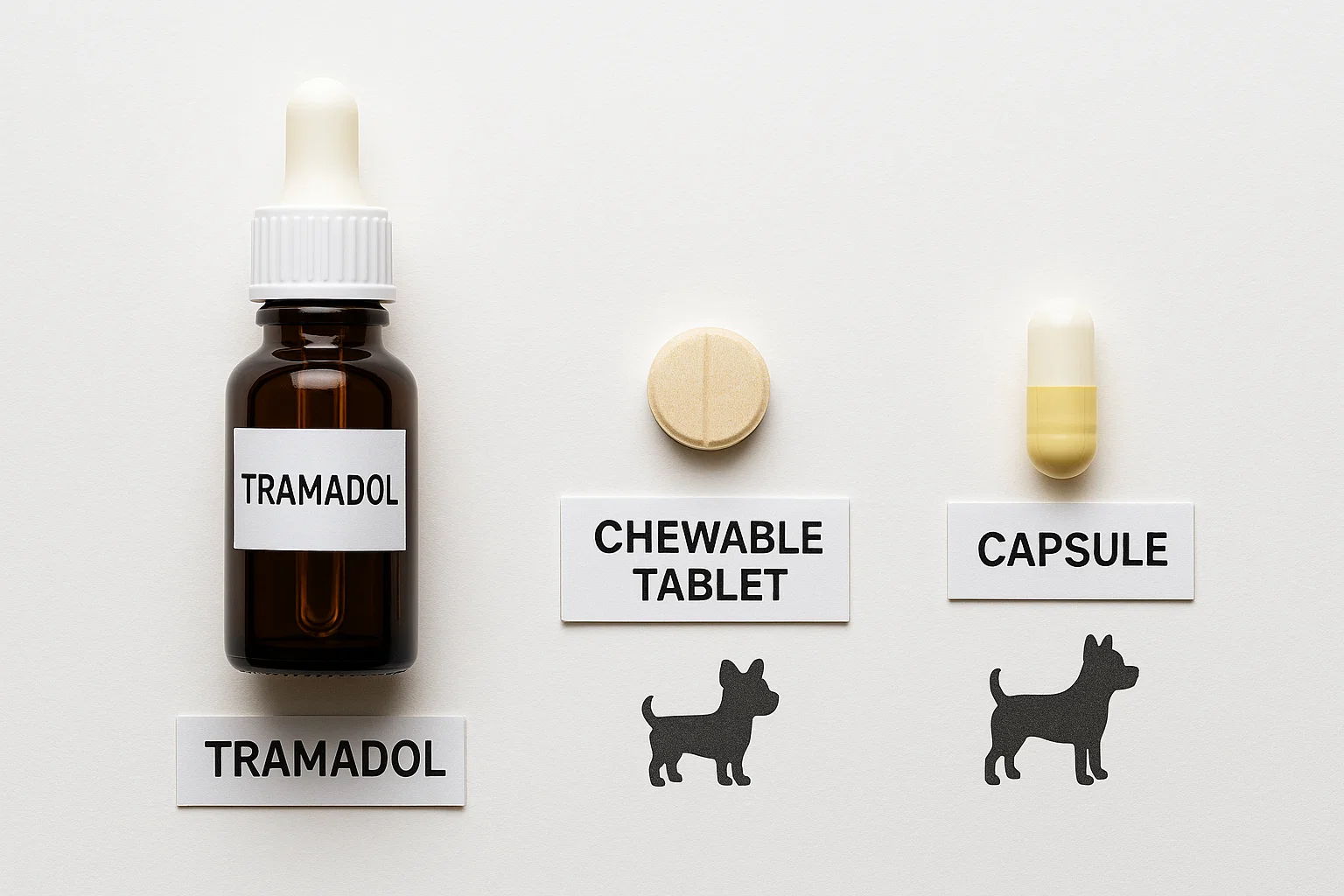If you’re a pet parent or an SEO writer researching health topics for your site, you’ve likely come across the term tramadol for dogs. Whether your dog has been prescribed this medication or you’re simply optimizing a pet health blog post, understanding what tramadol is, how it works, and its safety guidelines is critical.
In this comprehensive guide, we’ll break down everything you need to know—step by step. From what tramadol actually does in a dog’s body to how to write about it responsibly as an SEO content creator, we’ll walk you through the science and the strategy.
What is Tramadol for Dogs?

Tramadol is a synthetic opioid used to manage moderate to severe pain in both humans and animals. In veterinary medicine, tramadol for dogs is often prescribed for post-surgery recovery, arthritis pain, cancer-related discomfort, or chronic conditions like intervertebral disc disease.
Unlike some medications, tramadol doesn’t cure the source of pain; it simply modifies the brain’s perception of pain by targeting the nervous system.
Quick facts:
- Drug class: Opioid analgesic
- Controlled substance: Yes (in some U.S. states)
- Delivery form: Oral tablets, capsules, compounded liquids
- Prescription only: Absolutely
How Tramadol Works in Dogs
Tramadol binds to mu-opioid receptors in the central nervous system. Once attached, it inhibits pain signals, making your dog feel more comfortable. It also increases serotonin and norepinephrine levels in the brain—chemicals linked to mood and well-being.
Why this matters:
While serotonin enhancement can be a plus, it also opens the door to potential interactions with other meds (like SSRIs) and a condition called serotonin syndrome if misused.
Common Use Cases for Tramadol in Dogs
Veterinarians often prescribe tramadol when:
- NSAIDs (like carprofen) are not enough or not suitable
- Postoperative pain management is required
- Your dog is aging and dealing with joint or back pain
- Pain from cancer, trauma, or chronic illness needs relief
Is Tramadol Safe for Dogs?
Yes—but with caveats.
When prescribed and dosed correctly, tramadol is generally safe. However, it’s not a one-size-fits-all medication. A dog’s size, breed, age, weight, liver/kidney function, and current medications all influence how safe tramadol is.
What makes tramadol risky?
- Incorrect dosing
- Drug interactions (like with antidepressants or seizure meds)
- Pre-existing conditions (especially liver/kidney disease)
Tramadol Dosage Guidelines for Dogs
Dosing is where many pet parents and content creators get confused.
Typical dosage:
- Range: 0.45 – 1.8 mg per pound
- Frequency: Every 8 to 12 hours
Example:
A 40-pound dog might be prescribed 25–50 mg every 8–12 hours depending on severity and individual factors.
Never guess your dog’s dose. Always consult a vet for proper measurement and adjustments.
Step-by-Step Guide to Administering Tramadol to Your Dog
- Get a prescription from your vet. Don’t use leftover human medication.
- Double-check dosage instructions. Ask questions if unclear.
- Use a pill pocket or mix with food. Tramadol has a bitter taste.
- Observe behavior and side effects. Keep notes for vet check-ins.
- Stick to the schedule. Skipping or doubling doses is risky.
Common Side Effects of Tramadol for Dogs
Even when dosed properly, tramadol can cause some side effects:
Mild (but common):
- Drowsiness
- Loss of appetite
- Nausea or vomiting
- Constipation
- Panting
Severe (requires vet attention):
- Seizures
- Agitation or confusion
- Tremors
- Collapse
- Rapid heart rate
- Serotonin syndrome
Pro tip: If your dog shows any dramatic mood changes or stops eating, reach out to your vet right away. tramadol for dogs
What to Avoid Mixing with Tramadol for Dogs
This is where it gets serious. Many people search for:
- “can I drink on Zepbound”
- “GLP-1 side effects”
- “weight-loss injections interactions”
While these are human-centric topics, they indirectly relate when pet owners are juggling their own meds alongside their pet’s care. tramadol for dogs
Dangerous mix-ins with tramadol:
- SSRIs like Prozac (fluoxetine)
- MAO inhibitors
- Tricyclic antidepressants
- Seizure meds like phenobarbital
- Sedatives or anti-anxiety meds
Even supplements like St. John’s Wort can increase the risk of serotonin syndrome.
Never add new medications or supplements without discussing them with your vet. tramadol for dogs
Tramadol Withdrawal and Long-Term Use
You might think opioids are only addictive in humans—but dogs can also develop dependence over long-term use.
Withdrawal signs include:
- Restlessness
- Whining
- Increased sensitivity to pain
- Vomiting or diarrhea
Always taper the dose gradually with your vet’s guidance when discontinuing tramadol.
SEO Strategy: Writing About Tramadol for Dogs Responsibly
If you’re creating content for pet health blogs, here are some best practices to optimize “tramadol for dogs” content without sacrificing accuracy or trustworthiness.
FAQs: Tramadol for Dogs
Can I give my dog human tramadol?
Not recommended. While it may be chemically similar, human versions can contain inactive ingredients dangerous to dogs. Always get pet-specific dosing.
How long does tramadol stay in a dog’s system?
Tramadol’s half-life in dogs is roughly 2 hours, but its effects can last up to 12 hours depending on the dosage and your dog’s metabolism.
Can I stop giving tramadol suddenly?
No. Stopping abruptly can lead to withdrawal symptoms. Talk to your vet about a tapering plan.
Is tramadol FDA-approved for dogs?
No, but it is commonly prescribed “off-label” by veterinarians based on clinical evidence and experience.
Tips for Pet Owners Managing Tramadol Use
- Create a medication logbook: Keep track of doses, times, and side effects.
- Use flavored pill pockets: Tramadol is notoriously bitter.
- Schedule bloodwork: Especially for long-term use or senior dogs.
- Monitor behavior changes: Energy level, appetite, and mood can indicate reactions.
- Avoid over-the-counter interactions: Even herbal remedies can cause harm.
What’s the Verdict?
Tramadol for dogs is a powerful pain relief tool—but it’s not without risks. With the proper guidance from your vet, clear communication, and a consistent dosing schedule, it can dramatically improve your dog’s quality of life.
As an SEO content writer or niche site blogger, you can bring value and clarity to pet parents by explaining these nuances honestly, accurately, and with empathy.
Final Thoughts
Whether you’re a loving dog owner or an SEO blogger crafting pet content, understanding how medications like tramadol for dogs work is crucial.
You don’t need a PhD in pharmacology—but you do need to respect how this medication affects your furry friend and how your audience perceives the info. Write with accuracy, empathy, and responsibility.
For dog owners, always consult your vet before starting or adjusting any medication. For bloggers and marketers, make sure your content is trustworthy, humanized, and optimized.
For more health insights, SEO strategies, and pet-care tips, visit [zepbound]!


